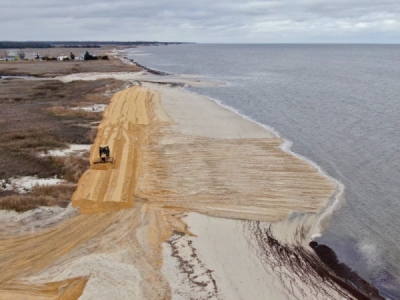
Posted on April 14, 2020
MIDDLE TOWNSHIP — A recently completed project has added tons of sand to a remote beach on the Delaware Bay ahead of the expected arrival of thousands of horseshoe crabs.
The crabs lay their eggs along the bay beaches from late April to the first week of May, depending on the water temperature and other factors, said Larry Niles, a wildlife biologist with Wildlife Restoration Partnerships who helped organize the project.
The spawning draws interest from naturalists from around the world, not for the crabs but for what else the huge amount of eggs draws: multiple species of migrating birds who depend on the eggs to fuel the rest of their northward journey. Birds like the semipalmated sandpiper have already begun to arrive, Niles said. Later, when the crab spawn is at its peak, more birds will come to the bayside beaches, including the red knot, which makes an extraordinary journey from South America to breeding grounds in the Arctic each spring.
Those birds often arrive by early May. They depend on the crab eggs to regain weight lost on their flight north, and the crabs in turn depend on the beaches. This year, there will be more beach for those eggs under a project spearheaded by the American Littoral Society and other groups.
The project was funded by a federal grant of $250,000 through the National Fish and Wildlife Foundation, Niles said, which had to be matched locally. That could include money raised through fundraising and local in-kind contributions, including volunteer time.
Cooks Beach is easy to miss. The stretch of bayside beach between two creeks through the marsh is accessible by a long dirt road off Route 47, with the nearest house about a half mile from the water. For the replenishment, about six tons of sand was trucked along that road and spread along the beach. The project was completed by the end of March.
“It took two weeks to make the beach, but it takes months to get the permits,” Niles said.
The project is of a far more modest scale than the now-familiar beach replenishment work on the ocean side of Cape May County, where federal and local governments spend millions to dredge sand from offshore shoals to pump onto eroded beaches.
Niles expects much of the added sand to erode quickly, but that’s OK.
“We’ve found that Cooks Beach is a feeder beach. On either side of Cooks Beach are small communities, Reeds Beach and Kimbles Beach,” he said. Some sand from this project will find its way onto those beaches as it is moved by the flowing water, and more sand will create shoals just off the beach. These are better than a steep drop-off for the crabs laying eggs, he said. And for the birds, offshore shoals present a better chance to find eggs at both high and low tides.
The stated goal of most beach replenishment projects is property protection. In this instance, the project is all about the birds and crabs.
“We’re doing this based on wildlife,” Niles said.
Middle Township Administrator Kimberly Krauss said the township has worked closely with Niles and the Littoral Society on the project. Township Committee on Monday unanimously approved a new ordinance banning most vehicles from bayside beaches.
At the meeting, held online due to social distancing rules, Mayor Tim Donohue cited both public safety and the damage vehicles do to beaches. He has also said some drivers get their cars stuck in the soft sand, creating headaches for the township.
This was the third attempt at approving the ordinance, with two previous versions scrapped as township officials worked out exceptions.
The final version of the ordinances allows those with oyster permits, state and local officials and accredited wildlife workers vehicular access to the beaches.
During the crab spawning, the state Division of Fish and Wildlife restricts access to the beaches. Many people want to see the birds, Niles said, but a single person can drive the birds away from an entire beach.
Now, access to the bayside beaches is limited to a small section near the road ends, with the public limited to an area behind a section of dune fence. This allows the public to see the animals — some get close enough to the fence to be photographed with a phone — while allowing the birds to feed without interruption.
“It’s going to be tricky this year,” Niles said. The wildlife organizations do not want to create a situation where people get too close to each other during the COVID-19 pandemic. One possibility is to have a volunteer steward at each access point, with the available space expanded to allow for distancing.
Source: pressofatlanticcity





